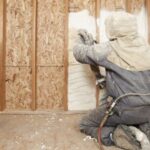DIY spray foam insulation

The DIY Spray Foam Insulation Process
Spray foam insulation kits include items such as a foam dispensing gun, hoses, and the two-part foam chemicals. The application process requires protective equipment (PPE), which includes gloves, goggles, a respirator, and full-body coveralls to protect against the chemical fumes and particles released during spraying. Proper ventilation is important, as fumes are hazardous until the foam fully cures.
Challenges of DIY Spray Foam Insulation
Cost-Benefit Analysis
DIY insulation kits may be cost-effective for small jobs, like sealing cracks or insulating a single room. However, for large areas like attics or walls, the risks and potential for error could make professional installation more cost-effective. Additionally, failed DIY insulation often requires professional remediation, which can double the costs you might have saved initially.
| Aspect | DIY Spray Foam | Professional Installation |
|---|---|---|
| Cost | Lower upfront for small areas | Higher but efficient for large areas |
| Risk of Error | High (off-ratio foam, uneven coverage) | Low (trained technicians) |
| Time Commitment | Significant (requires proper curing) | Faster and efficient |
| Safety Requirements | Requires extensive PPE and ventilation | Professionals handle safety aspects |
| Effectiveness | Varies (depends on DIY skill) | Consistent and warrantied |
Conclusion: Is DIY Spray Foam Insulation Worth It?
For small projects, DIY can work well, but for extensive insulation needs, professional installation will ensure better quality, fewer risks, and potentially lower long-term costs. If you’re considering a larger DIY project, it’s wise to consult a professional to avoid costly mistakes and safety issues.
For professional, reliable spray foam insulation services, contact Seamless Systems. We’re here to help with all your insulation needs! Call us at (307) 680-6103




